Using Nettles for Seasonal Allergies
March 2, 2017 by Ginger Hultin MS RDN
Springtime is a wonderful time of year when everything comes back to life again, but with that comes the start of allergy season. Dealing with seasonal allergies can be miserable. I for one experience this first hand every year. I’m very allergic to grass and that means a lot of sneezing from March/April through June in Seattle. There are many different ways you can support yourself and help alleviate allergy symptoms. One way to help combat allergy symptoms in the Seattle area is by utilizing stinging nettles. Stinging nettles are a nutrition powerhouse and can be used to fight seasonal allergies, let me explain more about this cool plant.
I regularly contribute to a very cool health and wellness site called Foodtrients where I write about evidence-based nutrition topics and wanted to be sure to share this one about how I get through allergy season with 5 Ways to Benefit from Nettles.
About Nettles
Growing naturally in many areas of the world, there is reason to believe that nettles have been used medicinally in Africa, Asia, Europe, and America for centuries. Chemical compounds have been identified in the roots, leaves, and hairs of the stinging nettle plant. These chemical compounds have been linked to antioxidant, anti-inflammatory and anti-viral effects and also may lower blood sugar and blood pressure levels. When cooked, nettles are rich in calcium, magnesium, iron, manganese, zinc, copper, and chromium. Fresh and dried nettles also contain antioxidants such as carotenoids chlorophyll and beta-carotene as well as flavonols and tannins.
Nutrition Powerhouse
Nettles are also a source of vitamins A, B1, B2, B9, C, E, and K. In addition to containing vitamins, they are considered a rich source of minerals such as calcium, potassium, phosphorus, magnesium, iron, and zinc. Heat, will neutralize the stinging part of this plant so it can be consumed in a variety of recipes and teas. They are also used in powdered or supplement form for a variety of therapeutic treatments.
Nature’s Allergy Remedy
An allergic response occurs when the body comes into contact with an allergen. Special immune cells called mast cells release the chemical histamine, which binds to different histamine receptors resulting in allergic responses. We are all familiar with those allergy signs and symptoms, such as a runny or stuffy nose, hives, and difficulty breathing. Nettles are used medicinally for many health conditions but are perhaps best known for treating seasonal allergies. Compounds have been found in nettles that help combat the inflammation and reactivity of allergy sufferers. For example, composites in nettles appear to inhibit inflammatory pathways and also act against the histamine receptors.
Safety and Interactions of Nettle Supplementation
Keep in mind that when used in supplement form, nettles are a natural blood thinner and may interact with some medications. Nettles may have the power to decrease blood sugars and blood pressure, causing levels to dip too low for some people. Discuss the use of nettles with your health care provider for safety and individual considerations. It may be difficult to correctly dose nettles in capsule form because there is no current standardization of extraction. Be sure to choose a trusted brand of supplement that has been third party tested for quality standards. Stinging nettles can cause intense skin irritation when fresh, be sure to use plenty of caution when handling nettles that have not yet been processed.
5 Ways to Benefit from Nettles
Here are my recommendations for how to easily incorporate nettles into your favorite recipes.
- Drinking nettle tea is a classic way to reap the benefit of this plant; purchase tea bags in stores or make your own if you have access to fresh leaves. Remember, processing with heat removes the stinging part of nettles so they become safe to consume.
- Blend cooked nettles into sauces such as pesto or use as a green in a red sauce on pasta or risotto.
- Simply sauté nettle greens with garlic, olive oil, and lemon for a nutritious side dish.
- Try nettle soup for an antioxidant-rich summer soup. Add flavor with onion, potato, and vegetable stock.
- Add to scrambles or omelets instead of spinach as an alternative green.
Harvesting Tips
It is easy to go out and harvest your own nettles, but before you do so it’s important to take the time and learn a little about proper handling and processing. It is best to harvest young nettles if you plan on cooking with them or making tea. They start to grow the first few weeks of spring. You can identify young stinging nettle plants by their purplish hue and heart-shaped leaves. As stinging nettle plants mature, their leaves lose that purplish hue and are vivid green in color. They measure about 2-5 inches long and have jagged edges with a heart-shaped base. When you go harvesting, make sure to wear long sleeves, long pants, and closed-toe shoes. Handling the nettles requires use of gloves to prevent getting stung by the nettles. Although harmless, you may develop an itchy rash if your skin comes into contact with the little hairs on the stems and leaves. After harvesting and processing, you can begin using nettles for your seasonal allergies.
Major Takeaway
Nettles are a nutritional powerhouse packed full of vitamins and minerals. Researchers have identified chemical compounds contained in the roots, leaves, and hairs of nettles which have been associated with lowering blood sugar and blood pressure all while having both anti-inflammatory and anti-viral properties. Harvest your own nettles and try out one of my 5 ways to benefit from nettles, but be sure to handle and process them properly. Using nettles for seasonal allergies is just one of the many ways to utilize this plant.
Want more info on herbs and natural remedies? I’ve got my 5 Foods that Don’t Deserve their Bad Reputations, Exploring the Food Trend Maca, Everything you need to know about Ginkgo, and Health Benefits of Reishi Mushrooms on the blog! Check it out.
How do you use nettles? Any luck with using them to treat allergies? Let me know in the comments what you think!
4 Comments
Leave a Comment

Ginger Hultin,MS, RD, CSO
Thanks for visiting! If you're struggling with a cancer diagnosis, autoimmune condition, gut health problems, or even a medical mystery, nutrition can make a HUGE difference in your day-to-day life. I run a virtual, concierge private practice where I partner with my clients over time to help them improve their health through nutrition. Be sure to visit the blog for easy, plant-based, anti-inflammatory recipes and our "Resources" page for a variety of self-paced programs, books, e-books, and nutrition podcast episodes.

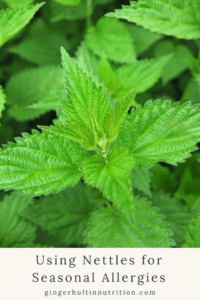
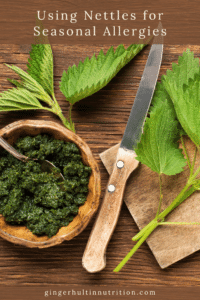
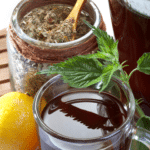
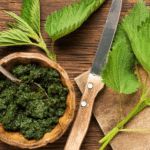
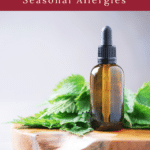
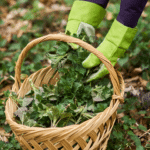
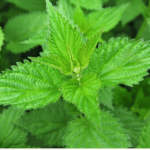
I am a lifelong allergy sufferer. This article is so great and I love the other uses for nettles you mentioned, such as in a pesto (my favorite)! Well done, Ginger!
The inside pulp of the horse tail plant will counteract the sting from nettles. Conveniently, they often grow near each other.
Plant life is necessary
100%! Agree with you so much 🙂 Thanks for stopping by!